MRS Applications
Oral
Spectroscopy & Non-Proton MR
Thursday, 21 June 2018
| S03 |
13:15 - 15:15 |
Moderators: Ovidiu Andronesi, Hermien Kan |
13:15
|
1147.
 |
 Correlating Proteoglycan Concentration in Intervertebral Discs Using 1H MR Spectroscopy with Lumber Lordotic Angle Correlating Proteoglycan Concentration in Intervertebral Discs Using 1H MR Spectroscopy with Lumber Lordotic Angle
Lisa Harris, Joely Smith, Ella Hodder, Michael Mills, Janice Bush, Vincent Pelling, Mara Cercignani, Nicholas Dowell
Both proteoglycan (PG) concentration and lumbar lordotic (LL) angle are linked with the health of spinal discs. Previously, it has been shown that PG concentration can reliably be measured using 1H MR Spectroscopy at 1.5T and that PG concentration is higher in female discs compared with male discs. This study has now been extended to show a correlation between PG and LL angle in a group of female participants.
|
13:27
|
1148.
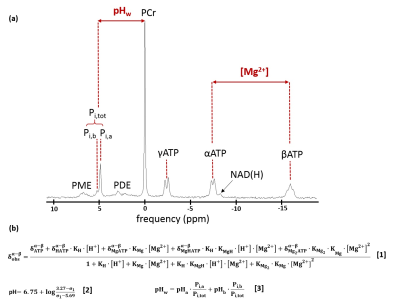 |
 31P NMRS-determined intramuscular Mg2+ and its relation to quantitative NMR imaging and spectroscopy outcome measures in Duchenne muscular dystrophy 31P NMRS-determined intramuscular Mg2+ and its relation to quantitative NMR imaging and spectroscopy outcome measures in Duchenne muscular dystrophy
Harmen Reyngoudt, Pierre Carlier
Free [Mg2+] determination with 31P NMRS is highly dependent on a precise knowledge of intracellular pH. The pH of Duchenne muscular dystrophy patients as determined by the 31P NMRS chemical shift of inorganic phosphate is abnormally alkaline. We have recently shown that intracellular pH in skeletal muscle could be determined using 1H NMRS of carnosine and that intracellular pH was alkaline in a proportion but not in all the DMD patients with a 31P NMRS-based alkaline pH. We decided to take advantage of this 1H NMRS-based intracellular determination to determine whether free intramuscular [Mg2+] is, in fact, abnormally low in DMD patients and investigate its relation with water T2 and fat fraction.
|
13:39
 |
1149.
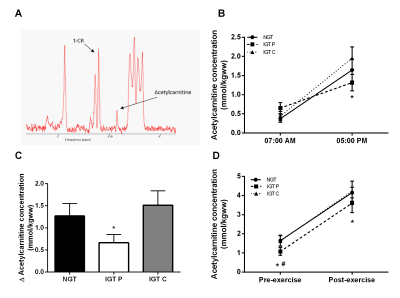 |
 Carnitine supplementation improves skeletal muscle acetylcarnitine formation and metabolic flexibility Carnitine supplementation improves skeletal muscle acetylcarnitine formation and metabolic flexibility
Yvonne Bruls, Marlies de Ligt, Esther Phielix, Bas Havekes, Joachim Wildberger, Matthijs Hesselink, Patrick Schrauwen, Lucas Lindeboom, Vera Schrauwen-Hinderling
The formation of acetylcarnitine may serve as a mitochondrial rescue mechanism to prevent the development of metabolic inflexibility and type 2 diabetes. We here used a novel magnetic resonance spectroscopy protocol, using long echo times, to determine acetylcarnitine concentrations in skeletal muscle in vivo. Carnitine supplementation enhanced the increase in acetylcarnitine concentration in resting muscle over the day as well as the capacity to form acetylcarnitine with exercise. Furthermore, carnitine supplementation completely restored metabolic flexibility suggesting that carnitine supplementation may be an interesting aid in improving disturbed metabolism in subjects prone to develop type 2 diabetes mellitus.
|
13:51
|
1150.
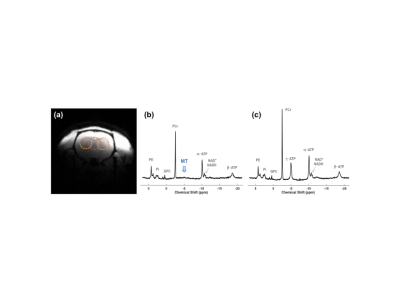 |
Why does a transient NAD+ infusion lead to a sustained increase in brain ATP levels? - A dynamic 31P MRS-MT imaging investigation at ultrahigh field
Video Permission Withheld
Xiao-Hong Zhu, Ming Lu, Yi Zhang, wei Chen
It has been observed recently that transient intraperitoneal infusion of oxidized nicotinamide adenine dinucleotide (NAD+) can increase intracellular ATP levels in healthy rat brain over time. Intrigued by this fascinating phenomenon, we investigated the dynamic changes of major phosphorous metabolites and the kinetics and metabolic rates of the ATP synthesis reactions in rat brain before and after introducing exogenous NAD+ using combined in vivo 31P MR spectroscopy (MRS) imaging with magnetization transfer (MT) technique at 16.4 Tesla magnet. The results of this comprehensive study provide important information for elucidating the cerebral energetic mechanism and regulation underlying this phenomenon.
|
14:03
 |
1151.
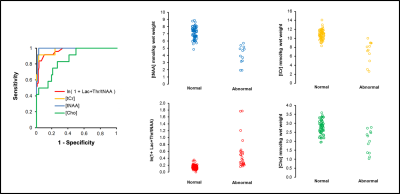 |
 Early MRS biomarkers accurately predict neurodevelopment after neonatal encephalopathy in a multicentre setting Early MRS biomarkers accurately predict neurodevelopment after neonatal encephalopathy in a multicentre setting
Peter Lally, Paolo Montaldo, Vānia Oliveira, Ravi Swamy, Gaurav Atreja, Josephine Mendoza, Alan Bainbridge, David Price, Aung Soe, Seetha Shankaran, Sudhin Thayyil
In neuroprotection trials for neonatal encephalopathy, the typical clinical outcome measures can only be measured reliably after a period of years. In a multicentre study covering eight sites and recruiting 224 infants, we demonstrate that MRS measures made within two weeks of birth provide quantitative and objective tools for predicting neurodevelopmental abnormalities usually only observed years after the initial injury. In particular, the thalamic concentration of tNAA (N-acetyl aspartate + N-acetyl aspartyl glutamate) has an area under the receiver operating characteristic curve of 0.99 (95%CI 0.98–1.00, n=82). Such tools could greatly speed up the next generation of clinical trials.
|
14:15
|
1152.
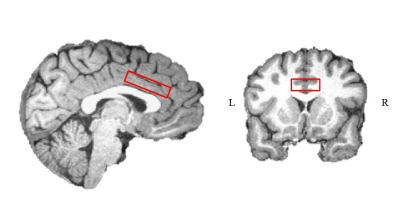 |
 Probing the Excitatory-Inhibitory Balance in Humans during Probabilistic Learning Probing the Excitatory-Inhibitory Balance in Humans during Probabilistic Learning
Vered Bezalel, Rony Paz, Assaf Tal
The dorsal anterior cingulate cortex (dACC) is crucial for reinforcement learning and decision-making. However, the excitatory and inhibitory mechanisms underlying these functions, governed by glutamate and GABA, are not properly understood. We used 1H-MRS to probe glutamate and GABA in the dACC during a task comprised of three conditions: discrimination, uncertainty and a null condition. A preference to higher gain option during the discrimination condition was reflected by elevated GABA levels during the uncertainty condition compared to the discrimination condition. Elevated GABA levels during the null condition predicted better behavioral-acquisition. These results indicate dACC involvement during learning of high load cognitive situation.
|
14:27
|
1153.
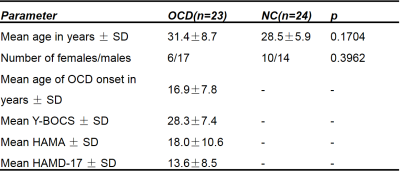 |
 Investigation of Anterior Cingulate Cortex ?-Aminobutyric Acid and Glutamate-Glutamine Levels in Patients with Obsessive-Compulsive Disorder by Proton Magnetic Resonance Spectroscopy Investigation of Anterior Cingulate Cortex ?-Aminobutyric Acid and Glutamate-Glutamine Levels in Patients with Obsessive-Compulsive Disorder by Proton Magnetic Resonance Spectroscopy
Yan Li, Naying He, Hongmin Xv, Zhijia Jin, ChenCheng Zhang, Weibo Chen, Yansong Zhao, Richard A. E. Edden, Fuhua Yan
The aim of this study is to evaluate the feasibility of 1H-MR edited spectroscopy for the detection of cerebral abnormalities in Obsessive-Compulsive Disorder (OCD) patients. Twenty-three OCD patients and Twenty-four normal controls (NC) underwent MRS. The γ-Aminobutyric Acid (GABA) and Glutamate-Glutamine (Glx) level of anterior cingulate cortex (ACC) was quantified based on the GANNET 2.0 software. Differences of GABA and Glx levels between two groups were analyzed using independent two sample t-test analysis. Relative to NC group, OCD patients had higher GABA concentration in the ACC (p<0.05), but had no significant difference in ACC Glx levels. To our knowledge, this study presents the first GABA concentration measurements within ACC in OCD patients. Our results suggested that GABA and Glx levels in the ACC might be promising diagnostic and monitoring biomarker for OCD.
|
14:39
 |
1154.
 |
 Increased spatial resolution of MR Spectroscopic Imaging improves the detectability of metabolic changes in Multiple Sclerosis lesions Increased spatial resolution of MR Spectroscopic Imaging improves the detectability of metabolic changes in Multiple Sclerosis lesions
Eva Heckova, Gilbert Hangel, Bernhard Strasser, Michal Považan, Assunta Dal-Bianco, Paulus Rommer, Elisabeth Springer, Stephan Gruber, Siegfried Trattnig, Wolfgang Bogner
MR Spectroscopic Imaging provides the ability to assess the abundance and spatial distribution of several neurometabolites, which are characteristic for pathophysiological processes related to the formation and development of Multiple Sclerosis lesions. In presented work we aimed to compare the detectability of metabolic changes in MS lesions for three different in-plane resolutions of MRSI, i.e. 2.2×2.2 mm2, 3.4×3.4 mm2 and 6.8×6.8 mm2. Our results suggest that the vast majority of metabolic changes in MS cannot be reliably assessed using MRSI with typical matrix sizes of 24x24 to 32x32. With ultra-high spatial resolution (2.2x2.2 mm2 in-plane) even very small MS lesions can be well resolved.
|
14:51
 |
1155.
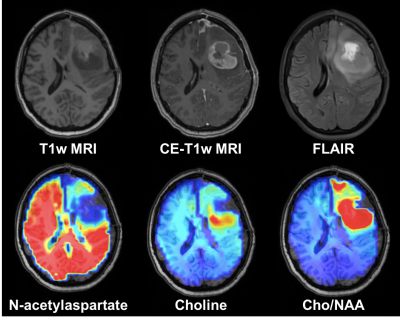 |
 A Feasibility Study of Radiation Therapy Dose Escalation Guided by Spectroscopic Magnetic Resonance Imaging in Patients with Glioblastoma A Feasibility Study of Radiation Therapy Dose Escalation Guided by Spectroscopic Magnetic Resonance Imaging in Patients with Glioblastoma
Saumya Gurbani, Eric Mellon, Brent Weinberg, Eduard Schreibmann, Andrew Maudlsey, Sulaiman Sheriff, Peter Barker, Lawrence Kleinberg, Lee Cooper, Hui-Kuo Shu, Hyunsuk Shim
Glioblastoma (GBM) is a grade IV primary brain tumor with poor outcomes despite surgical resection, chemotherapy, and radiation. Often, disease will recur in regions in the penumbra of the treatment volume, hypothesized to occur because anatomic MRI does not fully capture neoplastic infiltration. Spectroscopic magnetic resonance imaging (sMRI) enables in vivo whole-brain analysis of metabolic activity, and has been shown to sensitively and specifically identify regions of non-enhancing, infiltrating tumor. We present an ongoing prospective clinical study to target metabolically active tumor identified by sMRI for a radiation boost, with the aim of improving outcome in patients with GBM.
|
15:03
|
1156.
 |
 Predictive Value of Magnetic Resonance Spectroscopic Imaging during Anti-angiogenic Treatment in Recurrent Glioblastoma Predictive Value of Magnetic Resonance Spectroscopic Imaging during Anti-angiogenic Treatment in Recurrent Glioblastoma
Daniel Kim, Jorg Dietrich, Elizabeth Gerstner, Julian He, Otto Rapalino, Yangming Ou, Yi-Fen Yen, Mark Vangel, Ovidiu Andronesi, Isabel Arrillaga, Deborah Forst, Jayashree Kalpathy-Cramer , Bruce Rosen, Tracy Batchelor, Ramon Gonzalez, Eva-Maria Ratai
Our study examines the use of MR Spectroscopic Imaging to predict treatment response to anti-angiogenic therapy for recurrent glioblastoma patients. Our data demonstrated that early changes at 1-3 days, 4 weeks, and 6 weeks in Cho/NAA, Lac/nCr, and Lac/NAA can be predictive of 9-months survival outcomes in patients with recurrent glioblastoma treated with bevacizumab. Theses preliminary findings suggest that early changes in certain metabolic ratios can be useful markers for predicting therapeutic response to bevacizumab treatment.
|
|













